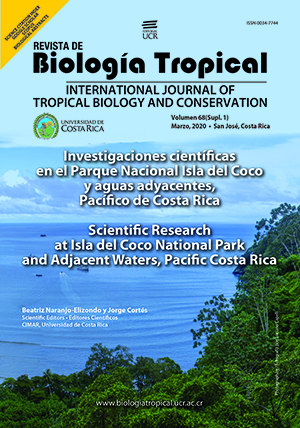Abstract
Introduction: Small terrestrial invertebrates disperse in a passive manner through wind currents, forming what is known as aerial plankton, which has not been surveyed yet for the Eastern Tropical Pacific. Documenting the aerial plankton of Isla del Coco will allow to better understand the colonization process of this highly diverse island. Objective: Characterize the aerial plankton present on the transect Puntarenas – Isla del Coco. Methods: Specimens were collected using entomological nets on 2 roundtrip voyages during the months of July and August of 2017 and 2018, respectively. Results: A total of 10 morpho-species were collected corresponding to the orders: Diptera (Ceratopogonidae, Milichiidae, and Nematocera of a non-identified family), Hymenoptera (Chalcidoidea: Agaonidae), Hemiptera (Scutelleridae and Coreidae) and Lepidoptera (Sphingidae). Diptera and Hymenoptera were collected on the nets; while, Hemiptera and Lepidoptera were found on the deck of the boat. No spiders were collected. The Diptera and Hymenoptera families, as well as the family Coreidae (Hemiptera), have been previously recorded on this type of surveys across the tropical Pacific. Conclusions: Two of the taxa collected by nets, Ceratopogonidae (Diptera) and Chalcidoidea (Hymenoptera), have representatives on Isla del Coco, which could provide direct support for wind dispersal as a colonization mechanism for these groups. We also detected other insects (i.e. Lepidoptera and Scutelleridae-Hemiptera) which most likely reached the boat by their own means providing evidence of their dispersal abilities. This research provides data to further expand on questions about the mechanisms of island colonization.
References
Albu, V. (2006). Kleptoparasitism, a very unusual relationship between a spider, its bee prey and some clever, opportunistic flies. Entomologica Romanica, 11, 87-88.
Amador, J. A., Durán-Quesada, A. M., Rivera, E. R., Mora, G., Sáenz, F., Calderón, B., & Mora, N. (2016). The easternmost tropical Pacific. Part II: Seasonal and intraseasonal modes of atmospheric variability. Revista de Biología Tropical, 64, S23-S57.
Bell, J. R., Bohan, D. A., Shaw, E. M., & Weyman, G. S. (2005). Ballooning dispersal using silk: world fauna, phylogenies, genetics and models. Bulletin of Entomological Research, 95, 69-114.
Bellon, H., Saenz, R., & Tournon, J. (1983). K-Ar radiometric ages of lavas from Cocos Island (Eastern Pacific). Marine Geology, 54, M17–M23.
Bristowe, W. S. (1931). A preliminary note on the spiders of Krakatau. Proceedings of the Zoological Society, 4, 1387-1401.
Calsbeek, R., & Smith, T. B. (2003). Ocean currents mediate evolution in island lizards. Nature, 426, 552-555.
Castillo, P., Batiza, R., Vanko, D., Malavassi, E., Barquero, J., & Fernandez, E. (1988). Anomalously young volcanoes on old hot-spot traces: I. Geology and petrology of Cocos Island. Bulletin of the Geological Society of America, 100, 1400-1414.
Gillespie, R. G., Baldwin, B. G., Waters, J. M., Fraser, C. I., Nikula, R., & Roderick, G. K. (2012). Long-distance dispersal: a framework for hypothesis testing. Trends in Ecology and Evolution, 27, 47-56.
Gressitt, J. L., Leech, R. E., & O’Brien, C. W. (1960). Trapping of air-borne insects in the Antarctic area. Pacific Insects, 2, 245-250.
Gressitt, J. L., Leech, R. E., Leech, T. S., Sedlacek, J., & Wise, K. A. J. (1961). Trapping of air-borne insects in the Antarctic area (Part 2). Pacific Insects, 3, 559-562.
Gutiérrez-Fonseca, P. E., Ramírez, A., Umaña, G., & Springer, M. (2013). Macroinvertebrados dulceacuícolas de la Isla del Coco, Costa Rica: especies y comparación con otras islas del Pacífico Tropical Oriental. Revista de Biología Tropical, 61, 657-668.
Hardy, A. C., & Cheng, L. (1986). Studies in the distribution of insects by aerial currents. III. Insect drift over the sea. Ecological Entomology, 11, 283-290.
Hogue, C. L., & Miller, S. E. (1981). Entomofauna of Cocos Island, Costa Rica. Atoll Research Bulletin, 250, 1-29.
Holzapfel, E. P., & Perkins, Jr B. D. (1969). Trapping of air-borne insects on ships on the Pacific, Part 7. Pacific Insects, 11, 455-476.
Jordano, P. (2017). What is long-distance dispersal? And a taxonomy of dispersal events. Journal of Ecology, 105, 75-84.
Kunte, K. (2005). Species composition, sex-ratios and movement patterns in Danaine butterfly migrations in southern India. Journal of the Bombay Natural History Society, 102, 280-286.
Larrivée, M., & Buddle, C. M. (2011). Ballooning propensity of canopy and understory spiders in a mature temperate hardwood forest. Ecological Entomology, 36(2), 144-151.
Montoya, M. (2015). Chapter 8. Isla del Coco: Terrestrial Ecosystems. In M. Kappelle (Ed.), Costa Rican Ecosystems (pp. 192- 244). Chicago: The University of Chicago Press.
Morley, E. L., & Robert, D. (2018). Electric Fields Elicit Ballooning in Spiders. Current Biology, 28, 2324-2330.
Nathan, R., Schurr, F. M., Spiegel, O., Steinitz, O., Trakhtenbrot, A., & Tsoar, A. (2008). Mechanisms of long-distance seed dispersal. Trends in Ecology and Evolution, 23, 638-647.
Okuma, C., & Kisimoto, R. (1981). Air Borne Spiders Collected over the East China Sea. Japanese Journal of Applied Entomology and Zoology, 25, 296-298.
Reynolds, A. M., Bohan, D. A., & Bell, J. R. (2007). Ballooning dispersal in arthropod taxa: conditions at take-off. Biology Letters, 3, 237-240.
Shanks, A. L. (2009). Pelagic larval duration and dispersal distance revisited. Biological Bulletin, 216, 373-385.
Simberloff, D. S., & Wilson E. O. (1969). Experimental Zoogeography of Islands: The colonization of Empty Islands. Ecology, 50, 278-296.
Urquhart, F. A., & Urquhart, N. R. (1978). Autumnal migration routes of the eastern population of the monarch butterfly (Danaus p. plexippus L.; Danaidae; Lepidoptera) in North America to the overwintering site in the Neovolcanic Plateau of Mexico. Canadian Journal of Zoology, 56, 1759-1764.
Trusty J. L., Kesler H. C., & Delgado G. H. (2006). Vascular Flora of Isla del Coco, Costa Rica. Proceedings of the California Academy of Sciences, 57, 247-355.
Yoshimoto, C. M., & Gressitt, J. L. (1960). Trapping of air-borne insects on ships on the Pacific (Part 3). Pacific Insects, 2, 239-243.
Yoshimoto, C. M., & Gressitt, J. L. (1961). Trapping of air-borne insects on ships on the Pacific (Part 4). Pacific Insects, 3, 556-558.
##plugins.facebook.comentarios##

This work is licensed under a Creative Commons Attribution 4.0 International License.
Copyright (c) 2020 Revista de Biología Tropical






